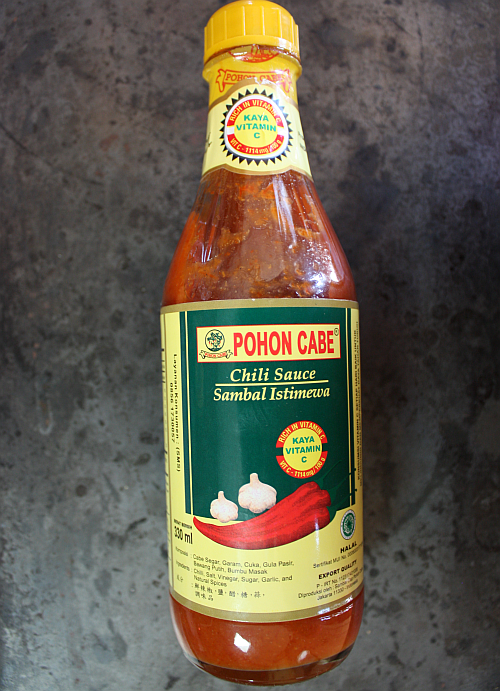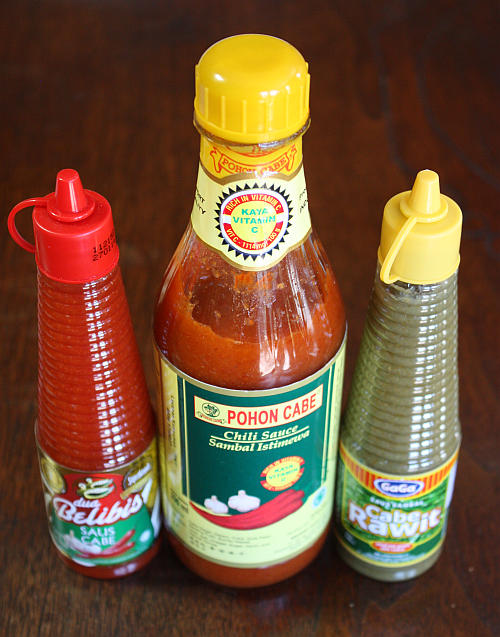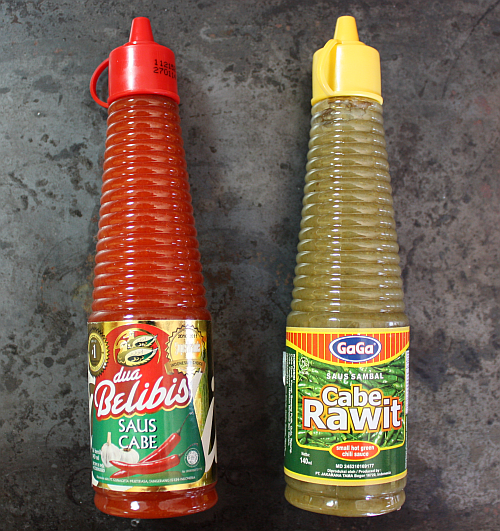I’ve been on the hunt for Asian hot sauces this week for a BonAppetit.com
assignment. There are tons to explore at Asian markets. The middle-of-the-night heartburn was worth it, I think...
During my search, I came across three unusual ones (above) at
Lion
Market in Saratoga (San Jose, CA). Lion doesn’t carry super offbeat ingredients
but once in a while, I discover gems. We didn’t include the three in the Bon
Appetit round up because they weren’t easily found in Manhattan and Indonesia was well represented in the piece.
That said, I save these three Indonesian “hotties” for VWK. I
like them but don’t fully understand them. Maybe you can lend your insights?
If you’re familiar with Indonesian chile sauces, the popular
ones are made by ABC (owned by Heinz). Tucked
near the ABC
Chili Sauces (Sambal Manis Pedas, Sambal Extra Pedas, and Sambal Asli), I found
mini squirt bottles of Gaga brand of Cabe
Rawit, a green chile sauce, and Dua Belibis brand of Saus Cabe, the red one. They’re both thick, potent and delicious.
The green one had more funk than the red one. I preferred the red one
more but the sight of the two made me wonder why the green chile version? Asian hot sauces don’t typically
come in green. They’re mainly reddish affairs.
Then there was Pohon Cabe brand of Sambal Istimewa, which I fell hard for. The bottle touts itself as
a source of Vitamin C but I can’t imagine eating enough to fortify myself with
vitamins. I suppose that Pohon Cabe expects you to consume lots of their sauce,
as if it’s a source of nutrition. I dig that but won’t try it.

But what is istimewa? Apparently
the term means special or extraordinary.
Online, I discovered Indonesian restaurants and resorts with istimewa as part their names. In
Malaysia and Singapore there are streets named Jalan Istimewa.
It seems like istimewa denotes
a certain high value that’s more than just saying something is tasty. I am not
100 percent sure and would love an assist.
In any event, the Pohon Cabe brand of special hot sauce is damn
delicious. Beautifully balanced in flavor and addictive. The bottle says that
it’s “hygenic, healthy, Halal, delicous and safe.” Ingredients included are
chile, salt, vinegar, sugar, garlic, and natural spices.
Do you have experience with any of these three Asian hot sauces?
I’m wondering about:
- How popular are these sauces in Indonesia, and
perhaps Singapore and Malaysia? - The double duck Dua Belibis brand claims to be
Indonesia’s “superbrand.” Is it? - What do people typically do with these sauces?
Are they simply table condiments or do you cook with them too?
Those are my burning questions. If you don’t know the answer, that’s
okay. Go out and try to find one of these and take a taste. Are they istimewa to you?
In the mood
to go hot sauce hunting? Get
yourself to an Asian market! Chinese, Vietnamese, Thai, and Indian markets are fabulous
hot sauce hunting grounds. Because things are inconsistently shelved, mine the
aisles and end caps. Pay attention to the condiment section filled with jars
and bottles of sauces and seasonings. If there’s a separate
Indonesian/Malaysian/Filipino aisle, check it out.
Sometimes, Asian markets group certain brands together so walk around
and keep your eyes open. And, transport the bottles upright on the way home.
Hot sauces are usually well sealed but you never know.
If you find something interesting shoot me a photo and email!
Related post: Sriracha Hot Sauce Week (links to articles and recipes on VWK, BA and BusinessWeek)



















matthijs says
Not an expert, sorry, and I haven't been there in 20 years, so I can't say if Dua Belibis is a superbrand now, but it certainly wasn't 20 years ago. The sauce types, however, were around back then. They were condiments, definitely. Maybe some streetside cooks added them to their fried noodles, but mostly they were something you just added yourself. In the context of street food they were common with vendors of Soto Ayam (chicken soup, basically): they'd make the soup for you and then you could spice it up with all sorts of sauces like these. Very popular with Westerners who could order plain Soto Ayam and forego the spicy condiments to end up with something that wasn't, unlike everything else in Indonesia, blazingly hot.
Green chilis were widely considered to be spicier than red ones, which is why they'd give you a green chili with your street snack rather than a red one (most people just discarded them). So a green chili sauce would be understood to be even hotter than a red one. Which would make it "istimewa", I guess.
Then again, like you said, anything is "istimewa" (special) in Indonesia. For example: you'd have "nasi goreng" (fried rice) and "nasi goreng istimewa" (fried rice with a fried egg on top).
Andrea Nguyen says
How interesting! Thanks for contributing your knowledge and experience. Prepared hot sauces were not a big deal in Vietnam when I was young and it's still not a big thing there. I suppose that Indonesia's sambal tradition led to all these commercial hot sauces. They are fascinating and complex.
As for "istimewa" -- I greatly appreciate the info. I kept thinking it was a place known for chile sauces and looking at geography.
Eva Km says
I'm Indonesian so I will try to answer your question.
First "Istimewa" mean special, but it's not big deal, every brand claims that they're special, right?
These kind of hot sauce itself is quite popular in Indonesia, we eat it as condiment (there goes your 3rd answer) but we don't cook with it. I myself prefer fresh sambal made from fresh chili but I know a couple of people in Indonesia who can't eat without properly putting some of these packaged sambal on their plate.
As for the brand, I am not quite sure. I am familiar with the Belibis one as it's the brand my grandmother used to use, instead of the more popular one "ABC". Gaga brand started out with canned sardines as far as I remember, but apparently they're making all kinds of sauce now. The Cabe Rawit one looks like "Sambal ijo Padang", special sambal Padang style made with green chili.
I hope that answers your questions
maluE says
oh, andrea, you just got me on an amazon.com shopping spree! .. got 2 bottles of the Pohan Cabe Chili Sauce Sambal Istimewa 330 ml, 1 bottle of Megah Sari Sambal Seafood 350 ml, and an assortment of pho bowls (fingers crossed, i hope the high reviews prove right) .. cost of shipping always makes me wince, until i calculate cost of driving + bridge toll + parking to find the items.
was your review/article only on asian hot sauces? .. i used to be a hot sauce fiend, but as i 'mature' 😉 it's flavor i look for .. i did find Shark brand sriracha on amazon - i regret not getting more than 1 bottle .. i'll be a Tabasco fan forever, but 2 other hot sauces are staples in our pantry - Inner Beauty (for beef) and Bonney Pepper (for pork and chicken).
Andrea Nguyen says
Eva, your insights are invaluable! Thank you. I totally agree that fresh sambal rules! Alas, people want convenience foods these days. These are pretty good though not perfect substitutes for from scratch stuff.
Andrea Nguyen says
Ha, I hear you. My stomach paid for the several days of hot sauce tasting. I'm no spring chicken anymore. ;-/
It'll be interesting to know how the hot sauces are sent to you. I mean... no broken bottles!
Linda | The Urban Mrs says
Hi Andrea, Yes, i've seen those hot sauces around Asian market here in SF. We, my family, enjoy dua belibis, partly because of the heat and texture. We eat hot sauces as condiment, like for meatball soup, noodles, or deep-fried food.
As for cabe rawit and pohon cabe - we normally make green chili at home; hence we never try both sauces.
Andrea Nguyen says
Linda, Thanks for the Bay Area confirmation on availability. I like your use of dua belibis in meatball soup. I bet it would totally perk up a Mexican albondigas.
Ronny says
I use Dua Belibis as a condiment (dip for deep fried stuff, or with steamed tofu pork) as well as for cooking chilli crabs. It has a distinctive sweetness to it, and it's quite hot for this type of chilli sauce, which works really well for chili crabs. I can get it easily here in Melbourne. I think Dua Belibis is quite popular back home, too.
I happen to have a small bottle of Gaga Cabe Rawit in my fridge which my mom brought from Indonesia a couple of months ago. I haven't tried it, but my mom ate it with pretty much everything (as a condiment). "Cabe rawit" literally means bird's eyes chillies, we quite often eat the green ones raw with deep fried (stuffed) tofu. Although similar in colour, Gaga Cabe Rawit is different in style to Sambal Lado Mudo (from Padang/Minang cooking), which is made with the young (thus green) version of the less-potent, thin, long red chillies. I probably would use it as a condiment for Bakso (beef balls soup). I think it's quite new, so not sure about popularity.
I've never seen or heard Pohon Cabe. There are a couple other brands which are well-known: ABC and Cap Jempol (thumb brand).
As for the "superbrands" thing, there's an Indonesian saying: there are no #2 kecap (most kecaps say they're #1). They tend to add those "awards" to the labels. I can't tell which of those awards are real anymore.
sports thesis says
Thanks for useful blog post. The blog post else may without delay I get that type of info written in such an perfect method? I've a mission that I'm just now operating on, and I have been at the look out for such information,
Noran says
I love Dua Belibis! Agree with Ronny, it's enjoyable because it has a pinch of garlic-ky sweetness but yet still is very spicy.
For the green ones (Gaga), Indonesians would mostly use it in soup-y Indo food, such as Soto (this is very good, if you love Pho, I bet you will love Soto), Rawon, Sop Buntut (Beef oxtail soup), Sop Kambing (Lamb soup), Pindang, etc etc - it gives the zing for broth and fat.
Never heard of Pohon Cabe. Really strange, because I always shop in wet market here in Jakarta, but never came across to Pohon Cabe brand before.
michlhw says
i'm from Singapore, but I've never seen those sauces before! Usually restaurants would make their own chili sauces, or source them in vats from centralized kitchens.. hence we never know the brand! It's very common in Singapore to have a thick, dark chili sauce swimming in chili oil---straits-style sambal with candlenut, red onions, and sometimes dried shrimp.
San mateo personal trainer says
Well I really want to admire the quality of this post.
I have read most of them, and learned a lot from them.
You are doing some great work.
Saphire says
The two red sauces are similar to cabe ABC and a staple in any Indonesian household. We use them for condiments in our house. Growing up we use to dip our KFC fried chicken or any fried chicken for that matter with ketchup mixed with cabe ABC.
As for the green one it has more bite since it uses thai chili. It's relatively new here, but I've found myself putting it on everything.
Especially in ramen noodles such as the famous Indomie. We would mix 3/4 of the seasoning, with the oil packet it comes with, and a squirt or two of the green cabe rawit sauce. Cook and drain the noodles and mix with the seasoning in a bowl and eat...that's comfort food.
Another use of the green chili sauce is I mix 2 eggs with touch of salt, pepper, about a teaspoon of green chili sauce(i like my food spicy) and a couple squirt of fish sauce, green onion is optional. Fry it using coconut oil if you have some or vegetable oil is ok too. you can fry it omelet style or scramble depending on your preference, and eat it with a bowl of rice...easy and quick meal.
David Kearns says
Sambal Dua Belibis is a relative new brand on the national market in Indonesia. It's significantly more expensive than the basic "Sambal ABC", but it's just as much significantly better quality. Tastes like they get twice as many or twice as good chilies in the sauce. We had to bring back a bunch on our last trip, and it quickly disappeared.
Aby says
hi, where can i buy this sos..from malaysia
Andrea Nguyen says
I found them at Chinese markets in California.